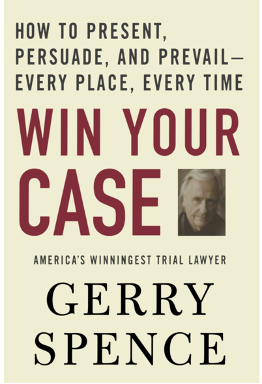Win Your Case: How to Present, Persuade, and Prevail—Every Place, Every Time
By: Gerry Spence

In short, this book is about how to argue passionately. It doesn’t provide any special phrases, nor does it offer any lessons in cadence, rhythm, or body language. It’s not about creating a presentation that appears passionate. Rather, it is genuinely focused on finding and creating an impassioned argument for justice.
Gerry Spence is a quintessential everyman’s lawyer. He drives an old pickup truck, wears a hide-fringe jacket, and represents ordinary individuals against enormous odds. And he begins this book with a unique view on advocacy skills:
“Ya can’t get nowhere with a thousand-dollar saddle on a ten-dollar horse.”
Spence’s view is that the tactics, techniques, and tricks of most trial practice books are the saddle. Worthwhile tools to be sure, but the horse—the trial lawyer and his ability to evoke passion and emotion—are what makes the real difference. To that end, Spence’s approach to advocacy requires a much more thoughtful, less mechanical approach to advocacy. In rhetorical terms, Spence focuses on ethos and pathos, while most trial advocacy books focus on logos.
Spence’s approach, thus, devotes the first 111 pages (of 278) to soft skills that must be learned well before trial. Through these soft skills, he attempts to instill a necessary sense of humanity, which he credibly argues is what allows a closer connection with the jury. The soft skills that Spence emphasizes are what most would generally describe as empathy and compassion, but Spence provides rich, vibrant color, devoting entire chapters to topics like:
• The Power of Discovering the Self
• The Magical Power of Feeling
• The Power of Fear—Ours and Theirs
Spence acknowledges that these skills are foreign to most lawyers who practice in a world that prides itself of stripping emotion from any decision making. And he recognizes that individuality is difficult in a profession that prizes conformity. But it’s precisely because most lawyers have overtrained their rational brains (logos) that these soft skills are so important.
Spence urges this pivot toward ethos and pathos for several reasons. To begin, to build trust with a jury, it’s critical that a trial lawyer is entirely comfortable and confident in front of his audience. That’s why Spence initially focuses on discovering a personal style, being vulnerable, and admitting flaws to build a humble confidence that jurors can trust. Next, jurors (like any audience) are persuaded by emotion. That’s not to say jurors will ignore the law or reason, but emotional hooks help motivate reasoning and will sway jurors’ understanding of a case. Therefore, it’s important for a trial lawyer to embrace feelings—his own, his client’s, and the jury’s.
What becomes clear as Spence develops these skills is that while many books emphasize the need for storytelling, Spence has mastered the art. Others focus on the mechanics of stories (chronology, details, climax), but without ever addressing it directly, Spence shares the key to great storytelling—deep characters and emotion. In doing so, Spence builds a case around a story that jurors don’t just see through vivid detail, but one that that they care about and feel connected to because he evokes powerful feelings. In fact, Spence has an entire pre-trial regimen in which he workshops scenes and characters, roleplaying to draw out each character’s emotions.
The second half of the book, then, applies many of the soft skills to specific aspects of trial. For example, to conduct an effective voir dire, Spence relies on his own vulnerabilities and flaws and understands the feelings of venire members (namely fear). For instance, Spence explains that asking about prejudices outright causes most people to clam up. But when he shares a genuine feeling or prejudice of his own, he builds trust and allows venire members to share their own feelings and prejudices, facilitating an open and candid conversation.
Spence applies the same skills to cross examination, concluding (like most authorities, but few practitioners): don’t attack witnesses. Instead, Spence suggests formulating cross examinations based on the jurors’ perspective of the witness, asking question like, who do they see? Do they trust the witness? Do they sympathize with the witness? Has the witness harmed your case? Then the cross examination must be built around a specific story to be conveyed through that witness, so that by the end, the jury sees who you want them to see.
In his discussion of final arguments, Spence goes back to the need for self-discovery. He believes the lawyer’s role is as a trusted guide, and he explains, “If we can dig deep into the mother lode of who we are, then deeper still, if we can become even more real, if we can shed all the masks, if we can be painfully honest we will become the guide the jury follows.”
Spence also ties the need for empathy and feeling to his final argument. In doing so, Spence formulates a powerful, passionate argument, not a mere summation: “The argument is an argument, the reasoning that supports justice, the creation of the aura of rightness that shines down on our case. But there can be no demand for justice until we ourselves feel the ethical anger, the pain, the loss, the righteous indignation.”
Although unconventional, Spence’s book is absolutely worth reading for anyone who cares about persuading others.